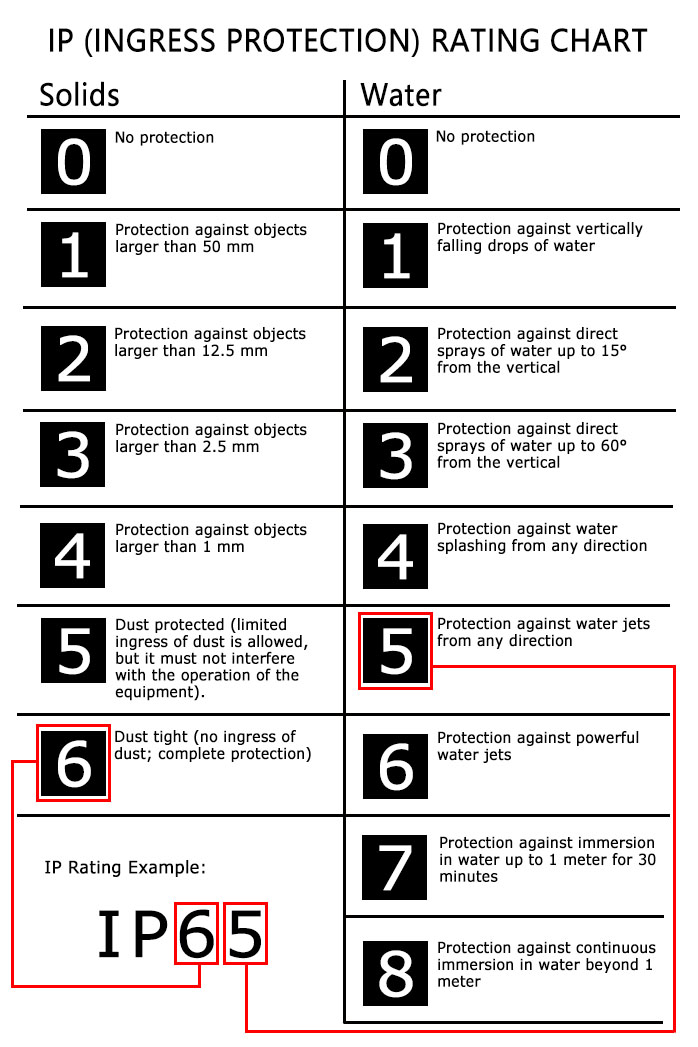Ingress Protection (IP) ratings
Understanding IP Ratings
IP ratings, or Ingress Protection ratings, are standardized codes that define the level of protection provided by the enclosures of electrical equipment. These ratings measure resistance to foreign objects (such as dust and water) and accidental contact. They are established under the international standard IEC 60529.
Structure of IP Ratings
An IP rating consists of the prefix "IP" followed by two digits:
-
First Digit: Indicates protection against solid particles.
-
Second Digit: Indicates protection against liquids.
Detailed Breakdown of IP Ratings
First Digit: Protection Against Solid Particles
This digit specifies the level of protection against solid objects, such as dust. Higher numbers represent greater protection.
-
0: No protection.
-
1: Protection against objects larger than 50 mm (e.g., a hand).
-
2: Protection against objects larger than 12.5 mm (e.g., a finger).
-
3: Protection against objects larger than 2.5 mm (e.g., tools, thick wires).
-
4: Protection against objects larger than 1 mm (e.g., most wires, screws).
-
5: Dust-protected (limited dust ingress allowed but not enough to harm equipment operation).
-
6: Dust-tight (completely protected against dust ingress).
Second Digit: Protection Against Liquids
This digit represents resistance to water or other liquids. Again, higher numbers indicate stronger protection.
-
0: No protection.
-
1: Protection against vertically falling water drops (e.g., condensation).
-
2: Protection against water sprayed at an angle up to 15° from vertical.
-
3: Protection against water sprayed at an angle up to 60° from vertical.
-
4: Protection against water splashing from any direction.
-
5: Protection against water jets from any direction.
-
6: Protection against powerful water jets.
-
7: Protection against temporary immersion in water (up to 1 meter for 30 minutes).
-
8: Protection against continuous immersion in water deeper than 1 meter (specific conditions defined by the manufacturer).
Common Examples of IP Ratings
-
IP67: Fully dust-tight and protected against immersion in water up to 1 meter for 30 minutes.
-
IP54: Limited protection against dust ingress and protection from water splashing from any direction.
-
IP68: Fully dust-tight and protected against continuous immersion in water beyond 1 meter, under conditions specified by the manufacturer.
Why IP Ratings Matter
IP ratings play a critical role in determining whether electrical equipment is suitable for specific environments and applications. They ensure that devices can operate safely and effectively under particular conditions without risking damage or failure.
For example:
-
Outdoor lighting: Requires high IP ratings to withstand exposure to dust, rain, and other environmental factors.
-
Smartphones: Need protection against accidental water immersion or dust ingress.
-
Industrial equipment: Demands robust protection to endure harsh conditions, ensuring reliable performance.
By understanding IP ratings, consumers and professionals can make informed decisions, selecting products designed to meet the demands of their environment. This knowledge contributes to the reliability and longevity of the equipment.

